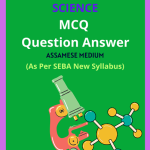Class 8 Science MCQ Chapter 16 Light Solutions in English Medium, Class 8 Science Multiple Choice Question Answer in English to each chapter is provided in the list so that you can easily browse throughout different chapters Class 8 Science MCQ Chapter 16 Light Notes and select need one.
Class 8 Science MCQ Chapter 16 Light
Also, you can read the SCERT book online in these sections Class 8 Science Objective Type Solutions by Expert Teachers as per SCERT (CBSE) Book guidelines. These solutions are part of SCERT All Subject Solutions. Here we have given Assam Class 8 Science MCQs Solutions in English for All Subject, You can practice these here.
Light
Chapter – 16
| MCQ |
1. An owl can see clearly at night but not day time because it has.
(a) More rods and few cones.
(b) Less rod and more cones.
(c) More rods and more cone.
(d) Less rods and less cones.
Ans: (a) More rods and few cones.
2. Which of the following is not a luminous object?
(a) sun.
(b) candle.
(c) moon.
(d) Tube light.
Ans: (c) moon.
3. Light passing through a prism splits into seven colours. This is called.
(a) Dispersion.
(b) Dissolution.
(c) Division.
(d) None of the above.
Ans: (a) Dispersion.
4. If the angle of incidence of light falling on a plane mirror is 30°, what will be the angle of reflection?
(a) 90°
(b) 60°
(c) 30°
(d) 0°
Ans: (c) 30°
5. Myopia can be corrected by using a:
(a) concave lens.
(b) convex lens.
(c) opaque lens.
(d) micro lens.
Ans: (a) concave lens.
6. In case of reflection of light, the angle of incidence (i) and the angle of reflection (r) are related as:
(a) i = r.
(b) i < r.
(c) i > r.
(d) no definite relation.
Ans: (a) i = r.
7. Name the type of mirror used as a back view mirror.
(a) Plane mirror.
(b) Concave mirror.
(c) Convex mirror.
(d) Any of these.
Ans: (c) Convex mirror.
8. Visually impaired people can read and write using.
(a) electronic writer.
(b) digital pens.
(c) braille system.
(d) hearing aids.
Ans: (c) braille system.
9. The image formed by a camera and a simple microscope are respectively.
(a) real and real.
(b) real and virtual.
(c) virtual and virtual.
(d) virtual and real.
Ans: (b) real and virtual.
10. What is the angle of incidence of a ray if the reflected ray is at an angle of 90° to the incident ray?
(a) 60°
(b) 45°
(c) 90°
(d) 180°
Ans: (b) 45°
11. The splitting of white light into its seven constituent colours is called
(a) refraction.
(b) dispersion.
(c) deviation.
(d) reflection.
Ans: (b) dispersion.
12. The defect due to which a person is not able to see the distant objects clearly:
(a) Myopia.
(b) Hypermetropia.
(c) Cornea.
(d) Cataract.
Ans: (a) Myopia.
13. The amount of light entering the eye is controlled by:
(a) eye lens.
(b) cornea.
(c) iris.
(d) ciliary muscle.
Ans: (c) iris.
14. Myopia can be corrected by using a:
(a) concave lens.
(b) convex lens.
(c) opaque lens.
(d) micro lens.
Ans: (a) concave lens.
15. Light enters the eye through.
(a) eye lens.
(b) pupil.
(c) cornea.
(d) retina.
Ans: (c) cornea.

Hi! my Name is Parimal Roy. I have completed my Bachelor’s degree in Philosophy (B.A.) from Silapathar General College. Currently, I am working as an HR Manager at Dev Library. It is a website that provides study materials for students from Class 3 to 12, including SCERT and NCERT notes. It also offers resources for BA, B.Com, B.Sc, and Computer Science, along with postgraduate notes. Besides study materials, the website has novels, eBooks, health and finance articles, biographies, quotes, and more.




